|
|
|
Published
on 31
Oct 2010
|
All rights reserved.
|
|
|
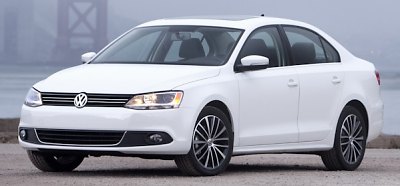
|
Volkswagen wants to triple its
American sales by 2018. Jetta will be crucial to this...
|
Volkswagen group has
a big
plan: it aims to replace Toyota as the world's number one car maker by
2018. To achieve this, it has to increase its sales from last year's
6.3 million units to 10 million units. How can it find the extra 3.7
million units ? Undoubtedly, emerging markets like China and Brazil
will be most significant, but North America can also contribute a lot.
Last year, Volkswagen sold 213,000 cars in the USA. While that figure
seems not bad, it is actually way lower than its key rivals - Toyota
sold 1.77 million cars in the same year; Honda sold 1.15 million units;
Both Nissan and Hyundai group did more than 700,000 units. More
embarrassing, even BMW and Mercedes sold about the same amount as the
mainstream German brand, so there is a lot of room for improvement.
Volkswagen aims to triple its US sales by 2018. In short term, it wants
to boost sales to the level of 400,000-450,000 units by 2012-2013. If
you were the sales boss of VW America, what would you say ?
You would argue that you are not given the right products to do so.
While the current Jetta and Passat have plenty of admirers for their
superior build quality, refinement and dynamics, they are just too
expensive to be popular in the USA. American motorists want cars to be
roomy, well equipped yet cheap to buy. If Volkswagen want to achieve
sales comparable to Corolla / Civic and Camry / Accord, it has to
abandon its premium image and go mainstream. The future Jetta and
Passat have to be significantly cheaper to produce yet offer more space
than the current cars. Just when you thought this must be a good excuse
not to follow the sales target, Wolfsburg HQ said, "Alright, I will
give you the right cars. Both the future Jetta and American Passat will
be designed specially for your market. They will be bigger and cheaper
and locally produced. No more excuse please."
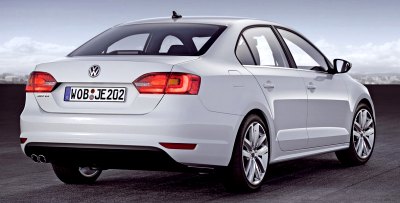 |
73 mm longer wheelbase means four
six-footers will be happy to travel in this car
|
So
here comes the new Jetta Mk6. For the first time in its history, it is
no longer a Golf plus a boot but a standalone model. Key difference to
its stablemate is a 73 mm longer wheelbase (2651 mm vs 2578 mm) which
translates to a remarkable 67 mm more rear seat legroom, so four
six-footers will be happy to travel in this car. Not so great is the
new styling. Although cutting ties with Golf liberates its design and
enabling a more coherent proportion than the previous Jetta, the new
nose and tail look quite bland, lacking the character of the old car.
The unique sense of high build quality has also disappeared. If that is
what Volkswagen America aim to rival Corolla and Civic, then we must
say it is disappointing.
In fact, to match the low prices of its Japanese rivals - base price of
new Jetta is just under US$16,000 - Volkswagen committed a lot more
sins. It replaced the sophisticated multi-link rear suspensions with a
much cheaper torsion beam. Power steering is reverted to pure hydraulic
assistance. It degraded the interior plastics and switch
gears, so you will find much the same shinny hard plastic dashboard and
downmarket switch gears as in its Japanese rivals. The seats are
adjusted manually. The center console is simplified and the navigation
screen is small. It has lost the smell of luxury. However, the parts
are still well screwed together, and the general lack of wind and road
noise still speak of a German car.
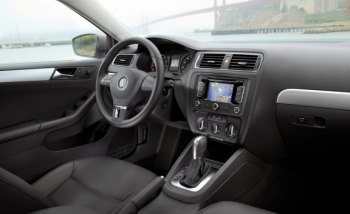
|
The unique sense of high build quality
has disappeared...
|
Further cost saving can be found under the bonnet. To make
the US$16,000 entry-level price possible, Volkswagen shamelessly
resurrected the old 115hp 2.0-liter 8V engine from Beetle. In fact, its
history can be traced back to the 1991 Golf Mk3, and I remember it was
already criticized for outdated back then. In the new car, its lack of
punch and refinement is even more apparent.
More sales are likely to go to the mid-trim 170hp 2.5-liter 20V
straight-five. It is carried over from the outgoing Jetta, so hardly
state of the art. Volkswagen found the larger and unsophisticated
engine is actually cheaper to produce than its small and efficient TSI
engines, so let the customers pay higher fuel bills for the lower
purchase price. This Jetta takes about 8.5 seconds to go from 0-60,
neither good nor bad, or about the same pace as the comparable Corolla
and Civic.
The last two engines are the the most expensive but also the best:
140hp 2.0TDI diesel and 200hp 2.0 TSI petrol. The former is torquey,
refined and frugal, hence our pick of the range. The latter is reserved
for the hottest GLI model, which is also the only new Jetta retaining
multi-link rear suspensions. For transmission, Volkswagen offers the
familiar 5-speed manual, 6-speed manual and 6-speed DSG for your
selection.
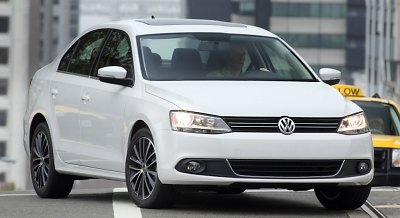
|
Downgraded everything is the price it
pays for going mainstream
|
On the road, the degraded Jetta still handles and rides
better than Corolla and Civic. Its European-style suspension tuning
leads to good body control and damping. Ride is generally smooth and
quiet. However, on poor surfaces the torsion-beam suspension does
generate more shocks and noise than the outgoing Jetta (or Golf). The
cheap hydraulic power steering delivers little feel on the straight
ahead. Furthermore, the electronic stability control is intrusive, and
it can't be switched off. Overall, the new Jetta does not deliver the
same driving fun as the old car, neither can it match Golf and Mazda 3.
Seeing the downgraded dynamics, refinement, build quality and even
style, existing American fans may be disappointed with the new Jetta.
Ironically, that's the price it pays for going mainstream. Will it
succeed ? I am not sure. What I am certain is it will inevitably hurt
the premium image Volkswagen has been renowned for. That doesn't seem
wise to me.
|
Verdict:    |
Published
on 31
Oct 2010
|
All rights reserved.
|
|
European Jetta
|
| While the American Jetta is made
cheap, the European Jetta retains most of the usual classy features to
meet the expectation of European customers. All European Jettas get
multi-link rear suspensions and electro-mechanical power steering like
Golf. Their interior is also made of soft-touch plastics and better
trimmings. Engines are the usual small TSI and TDI engines, including
105hp 1.2TSI, 122hp and 160hp 1.4TSI, 200hp 2.0TSI, 105hp 1.6TDI, 140hp
and 170hp 2.0TDI. They should be considerably better and cleaner to
drive than its American sibling, although no better to look. Production
still takes place at the Mexican plant together with the American Jetta. |
Verdict:     |
Published
on 5
Nov 2012
|
All rights reserved.
|
|
Jetta Hybrid
|
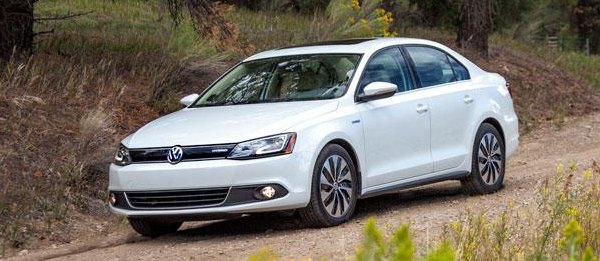
|
Until now Hybrid is
still a term downplayed by German car makers. They believe super-frugal
diesels are the way to go if you want to achieve the best fuel
efficiency, therefore they devote little money in the research and
development of hybrid vehicles. However, the North America market has
strong desire for hybrids. Seeing the unprecedented success of Toyota
Prius, German giant Volkswagen also starts taking hybrid seriously. Its
first serious attempt is Jetta Hybrid.
Unlike Toyota, Volkswagen wants to sacrifice a few mpg in exchange for
stronger performance and driver appeal that you would expect for a
German car. To do this, it fits the Jetta Hybrid with a relatively
powerful engine – the new EA211 family 1.4 TSI engine, completed with
all-alloy construction, dual-VVT, direct injection and turbocharger.
Just see its long list of technology will understand why the
small-capacity unit can pump out as much as 150 horsepower and a
remarkable 184 pound-foot of torque from 1400 to 3500 rpm. The electric
motor adds another 27 hp and 114 lbft, resulting in a total of 170 hp
and 184 lbft – the maximum torque could have been higher still if not
limited by the torque capacity of gearbox.
Speaking of gearbox, the 7-speed DSG is a world's first for hybrids.
Its crisped and responsive gearshift is far more satisfying than CVTs
employed by conventional hybrids. It also aids the already strong
performance. VW claims the car sprint from rest to 60 mph in 8.6
seconds, but it feels far quicker than the number suggested, especially
in the presence of electric torque at low rpm. No wonder VW America
markets this car as Jetta Turbo Hybrid
to emphasize its outstanding performance.
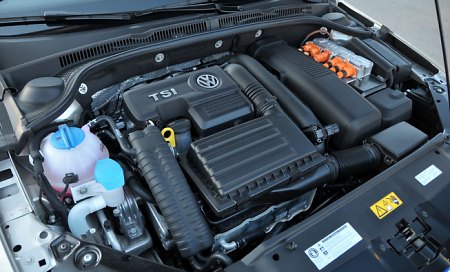
|
Then what about fuel efficiency? At the time of writing the official
EPA figures are yet to be released, but the company estimates 45 mpg
combined, which falls short of Prius (50 mpg), Ford Fusion Hybrid (47
mpg) and C-Max Hybrid (also 47 mpg) but better than Honda Civic Hybrid
(44 mpg), Acura ILX Hybrid (38 mpg) and Lexus CT200h (42 mpg), even
though the European car delivers stronger performance. This must thanks
to the efficient TSI engine as well as other improvement efforts, such
as the revised spoilers and underbody panels that reduce the drag
coefficient from 0.30 to 0.28, the use of low rolling resistance tires,
engine coast mode, and auto stop-start.
Apart from the nice combination of performance and fuel economy, the
Jetta Hybrid can be praised in many areas. For example, its drivetrain
integration is excellent, displaying seamless transition between the
two propulsion sources. Its automatic stop-start system is incredibly
smooth and matured. The electric power steering delivers better feel
and weight than most rivals'. The handling and ride combination is
remarkable for a hybrid, although its extra weight does takes a little
bit edge from the turn-in compared with Jettas with smaller engines.
Fortunately, the Hybrid employs multi-link rear suspension like the
European version, so it actually rides and handles better than the
American 2.0 and 2.5 models.
Flaws are few. The brake feel is hampered by an abrupt transition
between regenerative braking and mechanical braking, something not
unusual on hybrid vehicles. Besides, the 1.1 kWh lithium-ion battery
creates a step in the boot and cut luggage capacity by 120 liters to
320 liters only. After all, the Jetta was not designed with hybrid in
mind from the outset. The next generation car based on MQB platform
will be better in this respect.
|
Verdict:     |
|
|
|
|
|
|
|
|
|
|
Jetta
1.4TSI (Euro)
|
2010
|
| Front-engined,
FWD |
Steel monocoque
|
Mainly steel
|
| 4644 / 1778 / 1453 mm |
| 2651 mm |
Inline-4
|
| 1390 cc |
DOHC 16 valves
|
| Turbo |
| DI |
122 hp
|
147 lbft
|
6-speed manual
|
F: strut
R: multi-link
|
-
|
| 205/55R16 |
1325 kg
|
125 mph (c)
|
9.2 (c)
|
| - |
|
Jetta
2.0 (US)
|
2010
|
| Front-engined,
FWD |
Steel monocoque
|
Mainly steel
|
| 4644 / 1778 / 1453 mm |
| 2651 mm |
Inline-4
|
| 1984 cc |
SOHC 8 valves
|
| - |
| - |
115 hp
|
125 lbft
|
5-speed manual
|
F: strut
R: torsion-beam (changed to multi-link from late 2013)
|
-
|
| 195/65R15 |
1307 kg
|
118 mph (c)
|
11.0*
|
| 33.0* |
|
Jetta
2.5 (US)
|
2010
|
| Front-engined,
FWD |
Steel monocoque
|
Mainly steel
|
| 4644 / 1778 / 1453 mm |
| 2651 mm |
Inline-5
|
| 2480 cc |
DOHC 20 valves
|
| - |
| - |
170 hp
|
177 lbft
|
5-speed manual (6-spd auto)
|
F: strut
R: torsion-beam
|
-
|
| 225/45R17 |
1400 kg
|
126 mph (c)
|
8.2* (8.4*)
|
| 22.6* (23.9*) |
|
|
|
|
|
Performance
tested by: *C&D
|
|
|
|
|
|
|
Jetta
2.0TDI
|
2010
|
| Front-engined,
FWD |
Steel monocoque
|
Mainly steel
|
| 4644 / 1778 / 1453 mm |
| 2651 mm |
Inline-4, diesel
|
| 1968 cc |
DOHC 16 valves
|
VTG turbo
|
| CDI |
140 hp
|
236 lbft
|
6-speed twin-clutch
|
F: strut
R: multi-link
|
-
|
| 205/55R16 |
1366 kg
|
129 mph (c)
|
8.9 (c) / 8.0*
|
| 24.7* |
|
Jetta
2.0TSI / 2.0GLI
|
2010
|
| Front-engined,
FWD |
Steel monocoque
|
Mainly steel
|
| 4644 / 1778 / 1453 mm |
| 2651 mm |
Inline-4
|
| 1984 cc |
DOHC 16 valves, VVT
|
| Turbo |
| DI |
200 hp (210 hp from 2013)
|
207 lbft
|
6-speed twin-clutch
|
F: strut
R: multi-link
|
-
|
| 225/45R17 |
1375 kg
|
147 mph (c)
|
6.7 (c) / 6.4* / 6.5**
|
| 16.8* / 17.0** |
|
Jetta
Hybrid
|
2012
|
| Front-engined,
FWD |
Steel monocoque
|
Mainly steel
|
| 4644 / 1778 / 1453 mm |
| 2651 mm |
Inline-4 + electric motor
|
| 1395 cc |
DOHC 16 valves, DVVT
|
| Turbo |
| DI |
Engine: 150 hp
Motor: 27 hp
Combined: 170 hp
|
Engine: 184 lbft
Motor: 114 lbft
Combined: 184 lbft
|
7-speed twin-clutch
|
F: strut
R: multi-link
|
-
|
| 205/55R16 |
1502 kg
|
125 mph (limited)
|
8.6 (c) / 7.9*
|
| 22.2* |
|
|
|
|
|
| Performance
tested by: *C&D, **MT |
|
|
|
|
|
|
Jetta
1.8TSI (US)
|
2013
|
| Front-engined,
FWD |
Steel monocoque
|
Mainly steel
|
| 4644 / 1778 / 1453 mm |
| 2651 mm |
Inline-4
|
| 1798 cc |
DOHC 16 valves, VVT
|
| Turbo |
| DI |
170 hp
|
184 lbft
|
5-spd manual / 6-spd auto
|
F: strut
R: multi-link
|
-
|
| 205/55R16 |
1365 kg
|
126 mph (c)
|
5M: 7.2*
6A: 7.3*
|
5M: 19.0*
6A: 19.2*
|
|
|
|
|
|
|
|
| Performance
tested by: *C&D |
|
|
|
|
|
|
|
|
Copyright©
1997-2013
by Mark Wan @ AutoZine
|
|